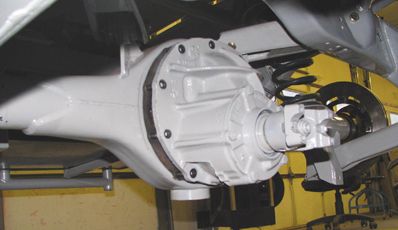
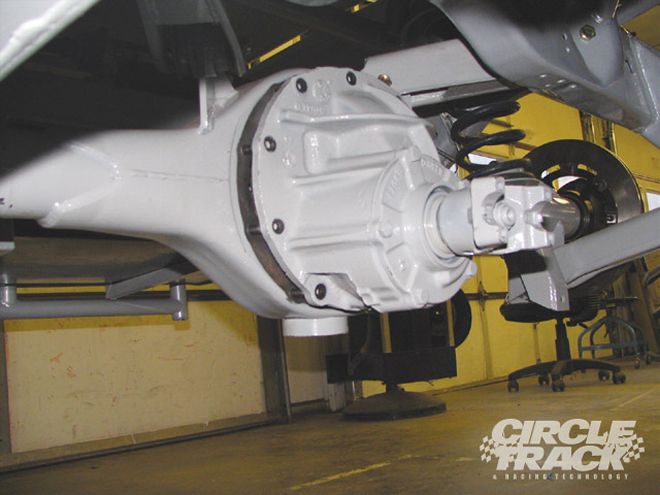
Decisions, Decisions
In the planning of Project Bomber, Frank Kimmel and I both knew we had to have a floater rearend. After all, this car is being built to run in Frank's Street Stock Nationals and the rules require floater rearends largely because the series races on tracks like Kentucky Speedway, Bristol Motor Speedway, Rockingham Raceway Park, and other high-banked, high-speed asphalt tracks.
However, we would have opted for one anyway regardless of the rules. You see, floaters have both axles splined on both ends and a hub assembly with two outer bearings on it which is retained with a hub nut. The design of the floater keeps everything together in the event that you break an axle. That's a huge safety benefit. In a non-floater rearend if you break an an axle, you could lose the wheel, which can be dangerous. Imagine a wheel bouncing down the track with the hub assembly and axle still attached. That situation has the potential to end very poorly.
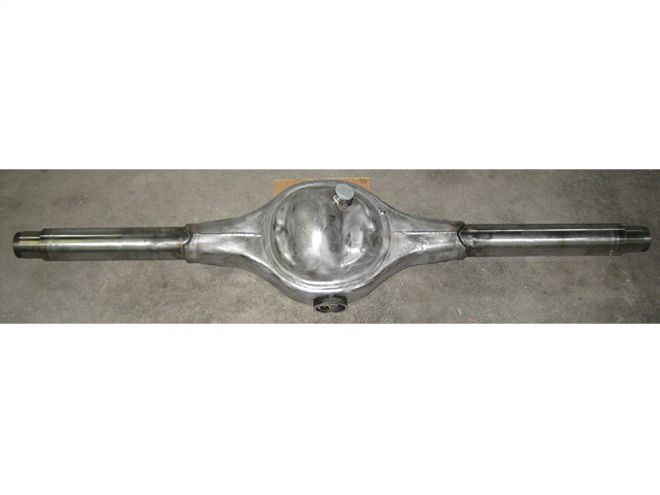 The boys at Quick Performance start with a bare housing and will build a complete rearend for you. You can also buy the housings alone which start at $400.
The boys at Quick Performance start with a bare housing and will build a complete rearend for you. You can also buy the housings alone which start at $400.
For Project Bomber, we settled on a 9-inch Floater from Quick Performance, the Ames, Iowa-based race car rearend manufacturer. About 30 percent of the racers who run Frank's series have Quick Performance rearends in their cars as well.
In the process of ordering up the rear we took some time out with Quick's Doug DeMoss to get a little more information to help you out when making your own rearend selection.
Spool Vs. Locker
It's a pretty common question, which should I use a spool or a locker? To answer that question, however, you're going to need a little bit of knowledge and your track's rulebook. A spool locks the wheels, so that they always turn at the same speed, whereas a locker locks only when under power and unlocks when you lift the throttle going into the corner. As you might imagine the locker is the preferred rearend on a lower banked short track. "You'll want a locker if you're going from 130 on the straights to 45 entering the corners," says DeMoss.
In Frank's series, however, the cars run in a more steady state, in other words there isn't that tremendous rpm swing and you can almost flat foot it around the track. Many of the tracks have gentle radius curves with substantial banking. That means that spool is the preferred rear.
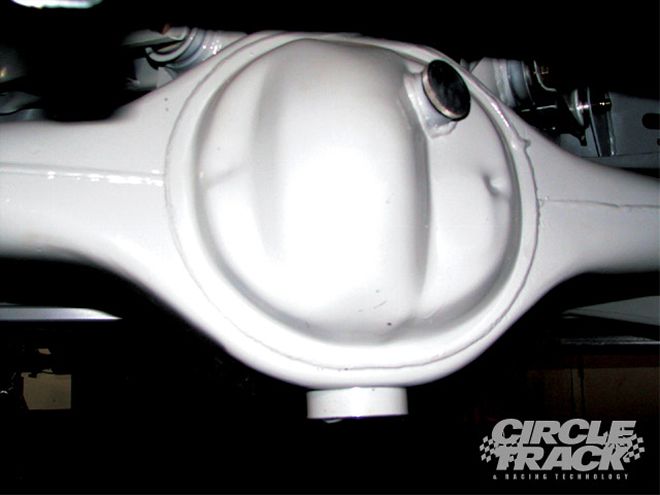 Here you can see both the drain and fill hole and the jack pad a nice feature which is standard with all of Quick's floater rearends. We painted this rearend in Frank's shop to match the powdercoated frame only because of time, but powdercoating would have been a good option.
Here you can see both the drain and fill hole and the jack pad a nice feature which is standard with all of Quick's floater rearends. We painted this rearend in Frank's shop to match the powdercoated frame only because of time, but powdercoating would have been a good option.
"If you don't turn the wheel hardly at all at your track and you can flat foot it all the way around, you'll want to go with a full spool, mini spool, or even an open carrier," says DeMoss. For comparison's sake a full spool will give you weight reduction while the open carrier gives a side to side benefit of not scrubbing horsepower off in the corners. A mini is somewhere in the middle.
For Kimmel's series, DeMoss goes on to say, "I'd probably just run an open carrier, you run those tracks in steady state so you're not going to break the tires loose." DeMoss has shipped a pretty even mix of rearends to FKSSN competitors-some mini, some full, some open carriers.
Gundrilled & Polishing
Another common question the guys at Quick Performance get is 'are gun-drilled axles worth the added expense?'
"Generally, gun-drilled axles are twice the price of a regular set with about a 2-pound weight savings," says DeMoss. "If you want to get technical about it, that mass reduction isn't going to affect the moment of inertia of the turning axles because the weight removed is so close to the center of the spinning mass. Again, because the Kimmel Street Stocks are running in such steady state, gun-drilled axles are not as critical. Lightening that part is not as big a benefit and you usually won't see anything in your lap times. In fact, I don't think any of our customers who run Frank's series have ordered gun-drilled axles."
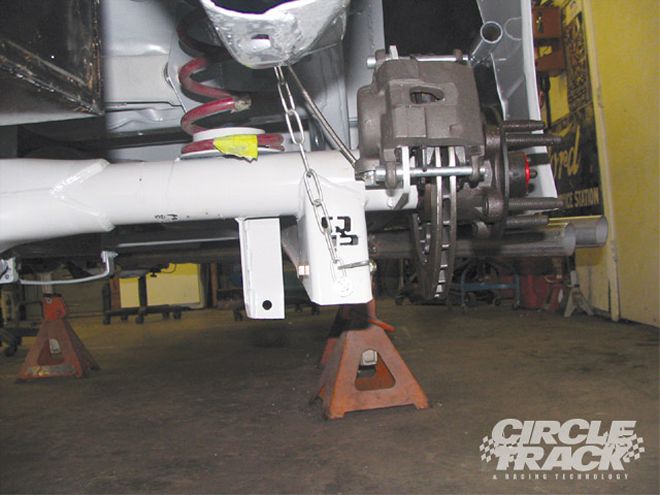 In this picture you'll note a chain bolted to the rearend housing; the other end is bolted to the framerail. This is an important step when installing your rearend. Because of how these rearends sit in the car, when you jack the car up, you need something to keep the springs in place, prevent snapping brake lines, and worst of all, bending your driveshaft on the driveshaft loop.
In this picture you'll note a chain bolted to the rearend housing; the other end is bolted to the framerail. This is an important step when installing your rearend. Because of how these rearends sit in the car, when you jack the car up, you need something to keep the springs in place, prevent snapping brake lines, and worst of all, bending your driveshaft on the driveshaft loop.
DeMoss says that polished gears fall into the same category as gun-drilled axles if you're racing in a Street Stock/Sportsman level. The coefficient of friction is less than 10 percent, and that 10 percent isn't going to show up in your lap times, especially if you race on dirt. "We haven't seen polished gears improve the service life, either," DeMoss says.
However, the key to getting the most out of standard gears is to take the time to break them in properly. Quick Performance recommends two to three heat cycles in the rearend before racing. Understanding that takes time-time a lot of Saturday night racers don't have-DeMoss says he jacks the car up and runs it in forward and reverse with it sitting on jackstands, and then drives it around in the pits as much as possible.
Getting Cool
Typically a rearend will run anywhere between 200 and 300 degrees, but the lower your gear ratio, the higher that temperature is going to climb. For example, a 7.00 gear is going to run a lot hotter than a 3.50 gear, which would usually run around the 250-degree range. If you run anything that's over 50 laps, you should seriously consider running a rearend cooler, especially if those 50-plus laps are on asphalt. However, in Frank's series the horsepower rating isn't high enough to warrant a rearend cooler. Adding a rearend cooler will, without a doubt, add cost that would be better spent elsewhere.
There is, however, something you can do to help keep your rear's temperature down without the added cost of a cooler, starting with the tube seals. "If you run them, don't," says DeMoss. "Tube seals prevent the oil from getting into the axle tubes which would actually help cool the oil, by keeping the oil out of the tubes the oil never cools and the rear's temperature can actually increase." DeMoss says just put four quarts of oil in there and go. By the way, go with mineral-based oil. According to DeMoss, the added cost of synthetics isn't worth it for this application, plus the mineral-based oils absorb heat better.
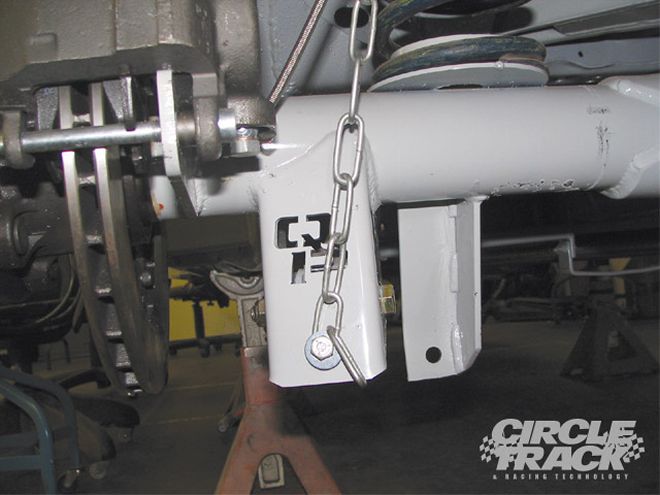 The chains have to be measured and bolted in at the proper length on both sides of the rear in order to ensure that everything stays in place and nothing is damaged when the car gets jacked up.
The chains have to be measured and bolted in at the proper length on both sides of the rear in order to ensure that everything stays in place and nothing is damaged when the car gets jacked up.
One Last Choice
Running a lightened ring gear can be equivalent to taking 10 to 30 pounds off the car, because it's rotating weight. Before you grab that gear and head over to the lathe, think again, you should leave ring gear lightening to the pros. DeMoss says, "There's no reduction in strength with a lightened ring gear as it comes out of the box. There is a reduction, however, when people lighten it themselves because they remove too much material and weaken the gear. There's a certain amount of material that can be removed before the safety factor comes into play, and we don't exceed that." The amount of material you can remove is directly related to the ratio of the gear. The lower the ratio, the more weight that can be safely taken off because the gear is thicker. Still, the safest way to gain the advantage is to leave the lightening to the pros.
Down To Business
When it comes time to order your new rearend it couldn't be simpler than picking up the phone. DeMoss and the boys at Quick Performance have been racing and building rearends for a long time. As such they have compiled a body of information from mounting locations, to pinion angles, to major sanction rules.
Basically before you get them on the phone you should know the make, model, and year of the frame of your race car, whether you're racing on asphalt or dirt, and whether you want a floater- or flange-style rear. In addition, you'll need to know the gear ratio and wheel width you want to run as well as whether you want a 28- or 31-spline axle. Take note here-a 31-spline axle is stronger and there is no reason not to go with that option unless you have 28 centers that you can't afford to or don't want to change
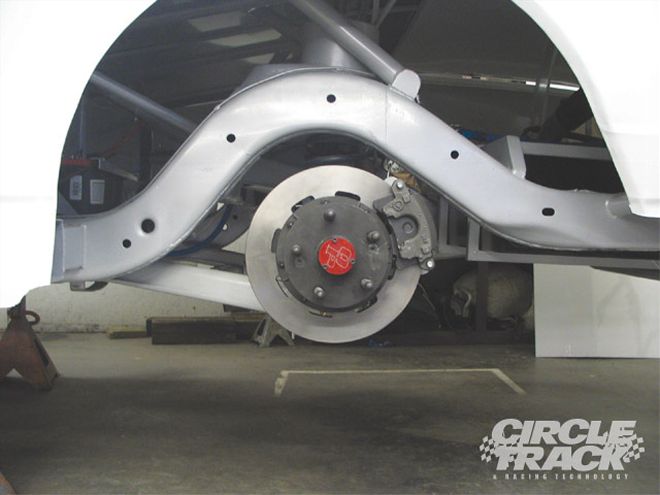 Quick's basic floater package includes all of the brackets in the correct location for your application, plus axles, hubs, bearings, studs, and rotors for $950 and for an extra $100 the company will even weld on caliper brackets and provide you with calipers and pads.
Quick's basic floater package includes all of the brackets in the correct location for your application, plus axles, hubs, bearings, studs, and rotors for $950 and for an extra $100 the company will even weld on caliper brackets and provide you with calipers and pads.
The basic package from Quick Performance that you see here includes all of the brackets in the correct location for your application, axles, hubs, bearings, studs, rotors, and more. Even the pinion angles are pre-determined by Quick, all for $950 and for an extra $100 Quick Performance will even weld on caliper brackets and provide you with calipers and pads. Overall, it's better for circle track racing. This package allows almost any backyard shade tree mechanic with basic tool skills to put current technology into his or her Street Stock.
Installation
There are some key practices that need to be observed in order to guarantee the performance of your new rearend. When installing, use the factory mounting bolts so long as they're in good condition. If not, and any bolts need to be replaced, grade-8 should always be used. Always use nylock nuts and don't overtighten anything. DeMoss says you should take all of the slack out and then go one more quarter turn. "You'd be surprised how many failures we see because of over-tightening." For example, your U-joint can go out 10 laps into a race because you crushed its cap by over-tightening it. The same thing can happen with the bushings if you crank down the nuts on the brackets too much. Bottom line is to use DeMoss' "no slack plus quarter turn" rule and you'll be fine.
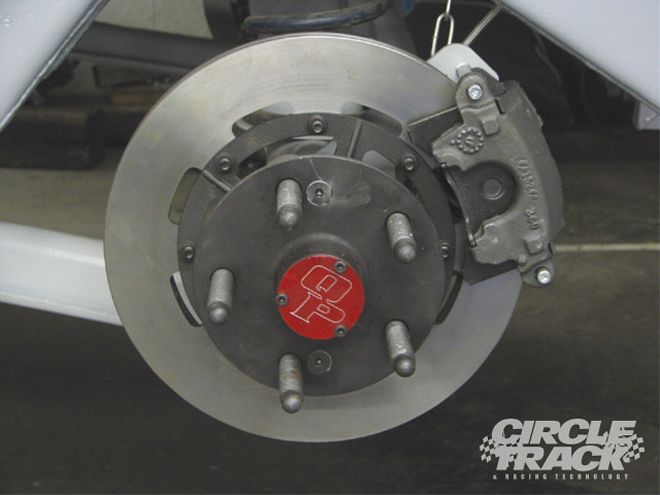
Another important step in the installation of your new rearend is attaching equal length chains from the rearend housing to the framerails. The chains should be equidistant apart on either side of the rear and bolted in place using, what else, but grade-8 bolts. When you jack the car up, the chains will prevent your springs from falling out of the spring buckets, as well as keeping your brake lines from snapping. It's critical, however, to measure the length of the chains, ensuring that they're short enough to prevent the driveshaft from contacting the driveshaft loop. If that happens, all of the weight of your rearend will be supported by only your driveshaft and it will bend.
You also have to be diligent about making sure the length is adjusted correctly. "I've seen guys at the ARCA level bend driveshafts because their chain lengths weren't properly adjusted, that can be an expensive mistake for anyone because your driveshaft is now junk," says Frank Kimmel.
Once the rearend is in place, you should thoroughly check all the mounting points and anywhere you tightened a nut or bolt ensuring that there's no suspension binding.
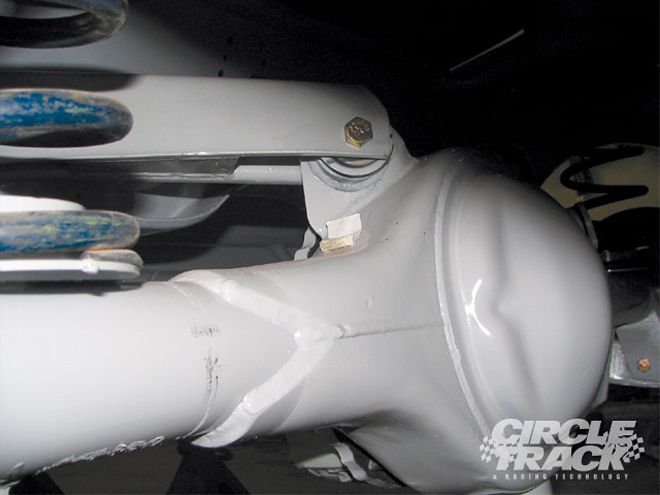
Wrapping It Up
Now that the hard part is done, there are a couple of items we'll pay particular attention to once the car is on the track and racing on a weekly basis. These simple maintenance tips should be followed by anybody racing a Street Stock-level class where the horsepower isn't outrageous. Inspect your rearend once a month, or after every four races, if you don't hit the track weekly. While you're inspecting the rear, go ahead and change the rearend oil at the same time. Again, Quick Performance always recommends a mineral-based oil over synthetic, largely because of the cost-benefit ratio. The additional money spent on synthetics can be put to better use elsewhere in a Street Stock-level car. Finally, make sure you have all of your shocks dyno'd before you install them, but only if you're interested in going after that big trophy at the end of the season.
Follow those three tips and your new floater will give you years of trouble-free racing.